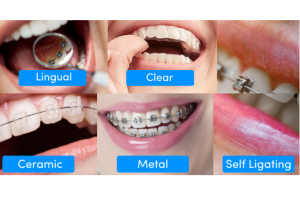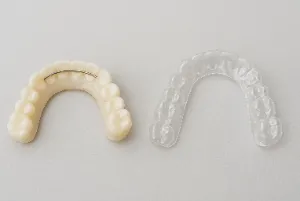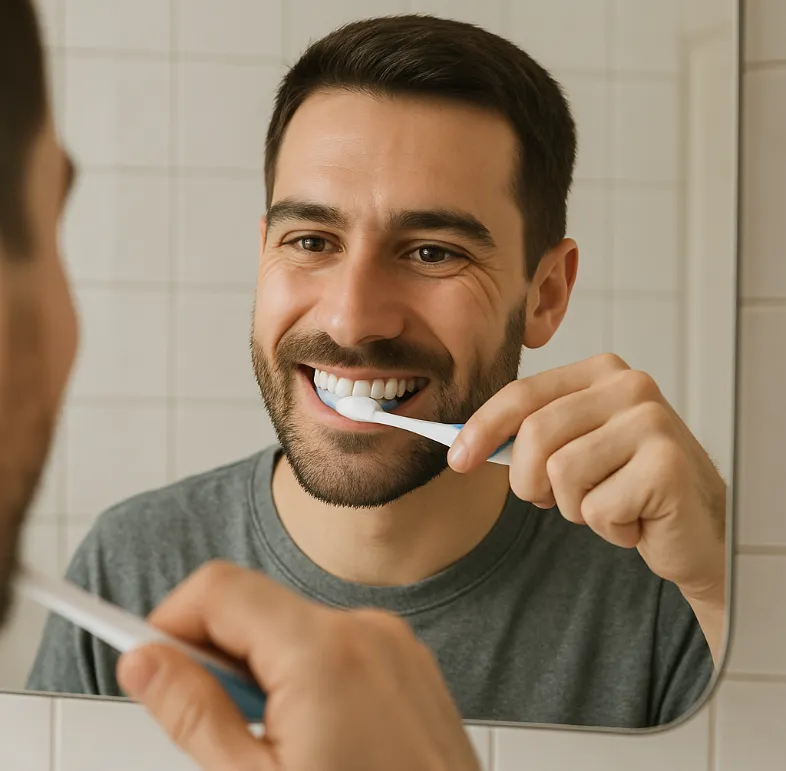.png)
If you’ve ever sat there wondering what the real difference is between a retainer and braces, trust us, you’re not the only one. Whether you’re just starting your teeth-straightening journey or finally finishing it, it’s super easy to get mixed up about when you need braces, when you need a retainer, and why both are even a thing in the first place.
Here’s the quick version: braces move your teeth, retainers keep them where they’re supposed to be. But of course, the braces vs retainers story is way more interesting than just that.
In this guide, we’re going to break it all down, what each one actually does, how much they cost, if there are situations where retainers are better than braces, and how to figure out which one’s right for you. By the end, you’ll get the full picture without drowning in confusing dental jargon.
Before we dive into the finer details, it’s important to understand the basic difference between a retainer and braces.
Braces are all about movement. They apply steady, gentle pressure to gradually shift your teeth into better alignment. Whether you’re dealing with crowding, gaps, or bite issues, braces are the active phase of treatment; they make the changes to your smile.
Retainers are all about protection. Once your teeth have been moved into their new positions, your mouth needs time to adapt. The surrounding gums, ligaments, and jawbone have a natural memory of where your teeth used to be, so without support, they can slowly drift back. Retainers prevent that from happening, keeping your teeth exactly where your braces left them.
Think of it like this: braces are the builders creating your new smile, while retainers are the guardians making sure that smile lasts for years to come.

Braces are basically the superheroes of the orthodontic world. They work by putting gentle but constant pressure on your teeth, jaw, and bite to slowly move everything into the right spots. Bit by bit, your teeth shift into their new positions, and before you know it, your smile looks better, works better, and feels way more balanced.
Braces are no longer just made of metal; modern methods of having braces now include many different techniques and materials.
The traditional and most widely used option, metal braces feature stainless steel brackets and wires that apply precise pressure to guide teeth into alignment. They are extremely durable and capable of correcting even the most complex orthodontic cases. While they are more visible, many patients personalise their look by choosing colourful elastic bands.
Ceramic braces are the closest to metal braces; they work exactly like metal braces but are slightly more discreet because the brackets are made with tooth coloured ceramic material. They are a popular choice among adults and teens seeking a more discreet treatment option. However, they are slightly more fragile and can require additional care to avoid staining.
Lingual braces are placed on the back (lingual side) of the teeth which makes them almost impossible to see from the front and that’s why they’re a favorite for people who want to straighten their teeth without anyone noticing but the trade-off is that they can take a lot longer to get used to because they sit so close to your tongue. They’re trickier to clean properly, plus they usually cost more than traditional braces, so you have to be ready for that commitment.
While technically not braces, clear aligners straighten teeth using a series of removable, nearly invisible trays. They are comfortable, convenient, and allow for normal eating and oral hygiene routines. Clear aligners are best suited for mild to moderate cases, but advancements in technology mean they can now address more complex alignment issues than in the past. Nowadays, we also have the option of at home aligners , so you can start your teeth straightening journey without visiting a dental clinic.

Retainers aren’t about moving your teeth; they’re about protecting your results. After braces (or aligners) are removed, your teeth are naturally tempted to wander back to their old positions. This process is called relapse. A retainer holds them in place while your gums, ligaments, and jawbone adapt to their new positions.
These are the kind you can take in and out as needed, and they come in two common styles:
Pros: Easy to clean, comfortable, discreet options available.
Cons: You have to remember to wear them, skip too many days, and your teeth may start shifting back.
These are thin wires bonded to the back of your teeth, usually along the lower front teeth (and sometimes the top). They work 24/7 without you having to think about it.
Pros: No risk of forgetting to wear them, great for long-term stability, especially for people with a history of crowding.
Cons: Can make flossing trickier, require extra attention to oral hygiene, and if the bond breaks, you’ll need to get it repaired quickly.
| Feature | Braces | Retainers |
|---|---|---|
| Purpose | Move teeth into new positions | Keep teeth in place after movement |
| When Worn | During active treatment | After active treatment |
| Cost | Higher (can range from £1,500–£5,500+) | Lower (£60–£400 typically) |
| Design | Brackets, wires, or aligner trays | Clear plastic, acrylic with wire, or fixed metal |
| Adjustment Needs | Regular tightening or tray changes | Occasional replacement or repair |
| Duration | Months to years | Often lifelong nightly wear |
This is like asking, Is a lock better than a key? They serve different purposes. Retainers aren’t a substitute for braces if your teeth need movement, they can't shift your teeth into place on their own. But if your teeth are already straight and you want to keep them that way, a retainer is exactly what you need. If anyone claims that retainers can straighten your teeth, it's a scam.
At-home remedies, whether they involve retainers or jaw exercises like mewing , can’t help teeth straightening; they only slightly (if at all) improve your tongue's posture or help support your jaw. For teeth straightening, you need a dentist-approved treatment plan.
When it comes to retainer vs braces, it’s not really a question of which one is “better”; they do completely different jobs, and in most cases, you’ll actually need both. Braces move your teeth into place, while retainers keep them there.
In some very mild cases, yes, but only under professional guidance. If your teeth are only slightly out of alignment, your orthodontist might recommend a special type of retainer that can make minor adjustments.
However, retainers are not designed to move teeth significantly. For noticeable crowding, gaps, or bite issues, braces or clear aligners are the only way to achieve major changes.
For most people, the sequence is clear: braces (or aligners) first, then retainers. Braces do the heavy lifting by actively shifting your teeth into their new positions. Retainers then step in to hold them there while your gums and bone stabilize.
The only time retainers come first is if you’ve already had braces or aligners in the past and just need to prevent your teeth from shifting again.
Are you still wondering, are retainers better than braces? Think of it this way: braces are like the construction crew that builds your dream house, while retainers are the locks on the doors and windows that keep everything secure.
After investing time, money, and patience into braces or aligners, a retainer is your safety net. It holds your teeth in their new positions while your gums, ligaments, and jawbone adapt. Without it, even a perfectly straight smile can start to shift back surprisingly fast.
When it comes to the braces vs retainers conversation, it’s not a competition; it’s a partnership. Braces (or clear aligners are the active force that moves your teeth into their ideal positions, correcting crowding, gaps, or bite issues. Retainers step in once that movement is done, acting as your long-term insurance policy against teeth shifting back.
Skipping braces means you can’t achieve major changes, and skipping retainers means you risk undoing all the hard work, time, and money you’ve invested. Whether you start with braces, aligners, or a mild correction with a retainer, the key is understanding that each plays a different but equally important role in your smile journey.
If you want lasting results, you need both parts of the process working together, the builders and the protectors, so your smile stays as perfect years from now as it is the day your treatment ends.




Curated the best for your knowledge
.png) Braces vs Retainers: Understanding the Key Differences
Braces vs Retainers: Understanding the Key DifferencesIf you’ve ever sat there wondering what the real difference is between a retainer and braces, trust us, you’re not the only one. Whether you’re just starting your teeth-straightening journey or finally finishing it, it’s super easy to get mixed up about when you need braces, when you need a retainer, and why both are even a thing in the first place. Here’s the quick version: braces move your teeth, retainers keep them where they’re supposed to be. But of course, the braces vs retainers story is way more interesting than just that. In this guide, we’re going to break it all down, what each one actually does, how much they cost, if there are situations where retainers are better than braces, and how to figure out which one’s right for you. By the end, you’ll get the full picture without drowning in confusing dental jargon.
Read More Importance of Dental Health for Men
Importance of Dental Health for MenDental health is important for all. Yet, for men, it often takes a backseat. It is now proven that neglecting dental health can lead to serious issues, even beyond the mouth. That’s why, gentlemen, it’s high time you start caring about your oral cavity seriously. The good news? Simple oral hygiene habits and regular check-ups can do the trick. You don’t need to follow some strict regimen. So, for men ready to turn a new leaf for their oral health, where do you start?
Read More How Much Does Teeth Straightening Cost?
How Much Does Teeth Straightening Cost?Teeth straightening kits are becoming increasingly popular due to their convenient use and affordability. When you purchase online clear aligners, it is referred to as DIY kits or teeth straightening kits. Aligners, being transparent, less painful, and more affordable, are taking a significant place in today’s era. Explore this blog to learn everything you need to know about teeth straightening cost, teeth straightening kits, and whether they are safe to use or not.
Read MoreQuick Links

Heading